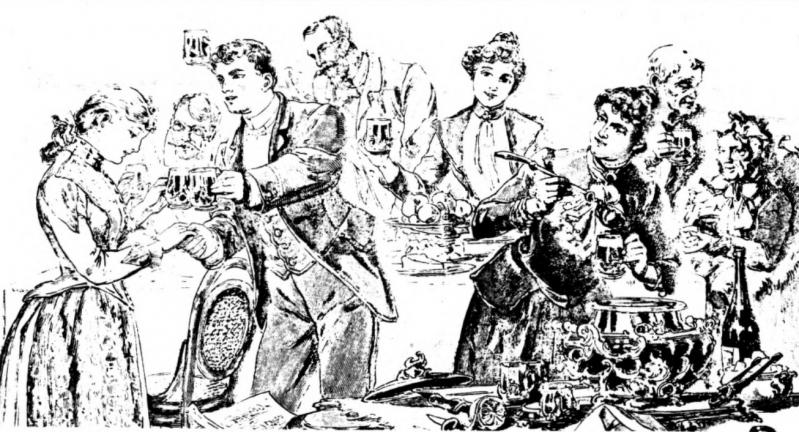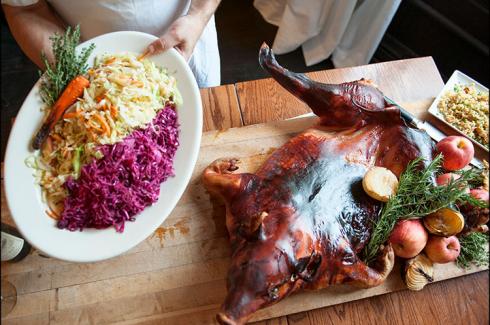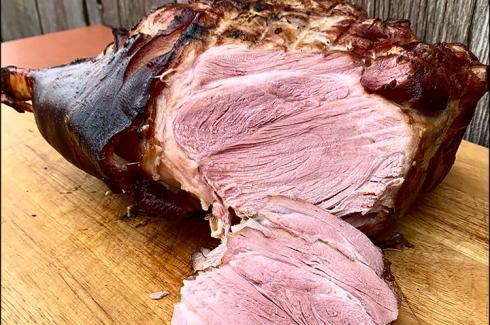“At Christmas play and make good cheer, For Christmas comes but once a year.” —Thomas Tusser, 1524-1580
This advice has been around for a long time and so have the many exhausted moans of “Thank God, thank God.” By now most of us have tied the ribbons and selected the Christmas feast, but there’s peripheral feasting to be done: Christmas Eve, and Boxing Day on the day after Christmas.
In my case, there’s a family birthday that pops up on the 26th, just when you think you can rest on your oars and that comforting line about Christmas coming “but once a year” rings hollow in your ears. There are Christmas parties and Christmas drop-ins to be dealt with by the genial host. To be always at the ready, there are fortunately some delicious things that can be made in advance and refrigerated and served on several occasions.
Smoked Eel Pate
The mere mention of eel sends chills up and down the spine of many people, but the eel after it is smoked changes character so dramatically that almost everybody adores it. It becomes somewhat dry with a rich, smoky, subtle flavor. In fact, don’t even say what it is until you have heard the first delighted sighs from guests. Makes about two cups.
2 medium-sized smoked eels
1/2 lb. unsalted butter, slightly softened
2 Tbsp. grated onion
Juice of 1/2 a lemon
Freshly milled black pepper to taste
Minced fresh parsley
Peel the eels and lift the flesh off the bones with a small knife (I find a clam knife ideal for this job). Break it into pieces and put it into a food processor with the butter. Process until smooth, then add grated onion and lemon juice. Spin briefly and add pepper, preferably rather coarsely cracked, until the pate has a nice, peppery aftertaste.
Pile this into a crock and decorate the top with a little minced parsley. Cover with plastic wrap and refrigerate until an hour before you wish to serve it. At room temperature it is of creamy spreadable consistency to put on crisp crackers, Finnish flat bread, or bagel crisps. It can be smoothed over and rewrapped or transferred to a smaller, clean bowl for its next appearance on your holiday board.
Salmon Rillettes
I first tasted this at the publishing world’s favorite watering hole (many of the moguls actually do drink only water from foreign springs), the Four Seasons. Rilettes in the classic French dish are shreds of long cooked pork beaten to a pate-like texture. This fish version should not be too smooth.
You may use fresh salmon, briefly poached, for this, but I really prefer the depth of color and flavor of best quality canned red Alaska sockeye salmon. The red caviar used may be tiny beads of inexpensive red lumpfish roe or the great glistening red eggs of the salmon which provides a lovely textural contrast to the creamy salmon flesh. Makes about two cups.
8 oz. can red Alaska sockeye salmon OR 1/2 lb. fresh salmon fillet, poached
1 Tbsp. minced scallion (white part only)
1/4 lb. (1 stick) unsalted butter, softened
1 tsp. freshly milled coarse white pepper
1/4 lb. good smoked salmon, sliced thick
1 Tbsp. tarragon flavored white wine vinegar
4 ozs. red salmon caviar
Pick over the salmon and discard skin and bones meticulously. (They are rich in calcium, but save the nutrition bit for a less festive occasion.) Set aside. Put the scallion, roughly chopped, into the processor and mince finely. Add butter and pepper and spin smooth.
Cut the smoked salmon into large pieces and add to the processor w ith the canned salmon and the wine vinegar. Run the processor in short pulses until well blended, but do not make a fine puree as the rillettes should have a somewhat rough texture. It isn’t necessary to use the finest Scottish smoked salmon in this dish, but best quality smoked Nova Scotia is the least you can do for it.
Remove the blade from the processor and stir in the salmon caviar. Pile it lightly into a stoneware mortar or some kind of crock, cover with plastic wrap and refrigerate until about an hour before serving. Add a generous spoonful of red caviar as a garnish and serve with tiny slices of dark pumpernickel or an assortment of breads and crackers.
This can be made a couple of days in advance and, if not all eaten, can be transferred to a smaller container and trotted out for another appearance at cocktail time.
Chicken Liver Mousse
Christmas is, of course, the time for goose and especially for its unctuous liver, the fabled foie gras. You can buy some perfectly delicious foie gras mousses for less than the usual Italian heir’s ransom, but this mousse of humble chicken livers is easy to make and holds its own with the expensive spread. In fact, it’s so economical to make you can splurge on a small tin of truffles to dress it up. Or go mad, mortgage the farm, and lavish your mousse with thin shavings of fresh white Italian truffles. Makes two pounds.
1 1/2 lbs. pale “blond” chicken livers (fresh, not frozen)
1/2 cup chopped onion
1 cup clear chicken broth
1/2 lb. unsalted butter, softened
1 tsp. salt
1 tsp. freshly milled white pepper
1/2 cup heavy cream
1 Tbsp. cognac
Truffles (opt.)
Rinse, dry, and trim the livers of all fat and membrane. Put them in a small non-aluminum (this metal discolors livers) saucepan with the onion and the chicken broth. Bring slowly to a simmer, cover and poach for 10 minutes, with the water just below the simmer. Do not boil. Remove from the burner and let the livers cool, uncovered, in the broth for 15 minutes. Drain them, discarding the liquid. Cool the livers to tepid in the refrigerator.
Put the livers, onion, butter, salt, and pepper into the food processor. Puree, then scrape into a bowl. Whip the cream until stiff and blend it with a spatula into the liver paste, which should be perfectly smooth and creamy. Season with cognac and add more salt and pepper if necessary. If using truffles, add them, finely chopped, at this point, along with their juices.
Turn the mousse into a terrine just large enough to hold it and cover it loosely with plastic wrap. When the surface of the mousse firms up in the refrigerator, press the plastic wrap down a little more firmly to exclude all air that could spoil the flavor or the color of the pale, delicate mousse. Refrigerate at least 24 hours before serving. Allow to soften at room temperature for half an hour or so before it is served with crisp, dry toast.





